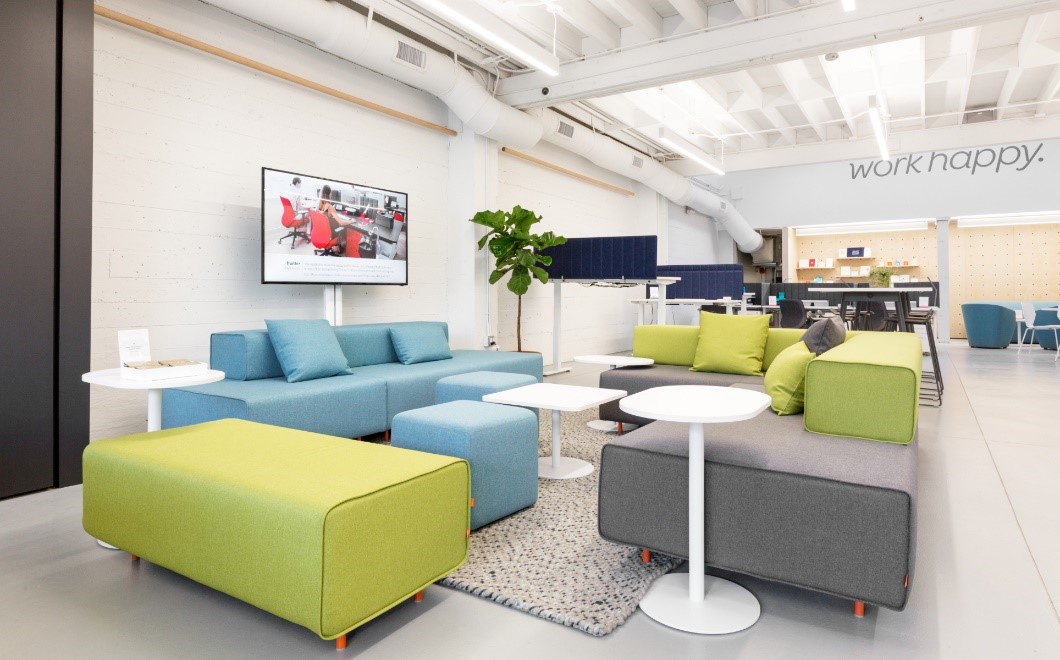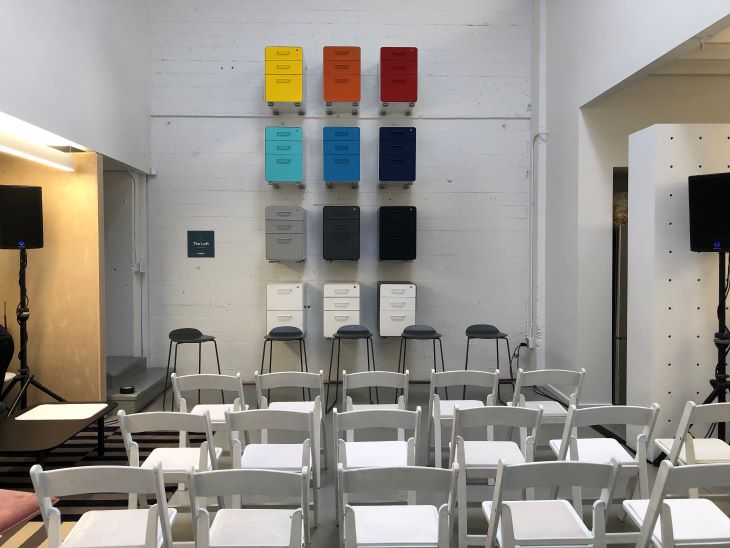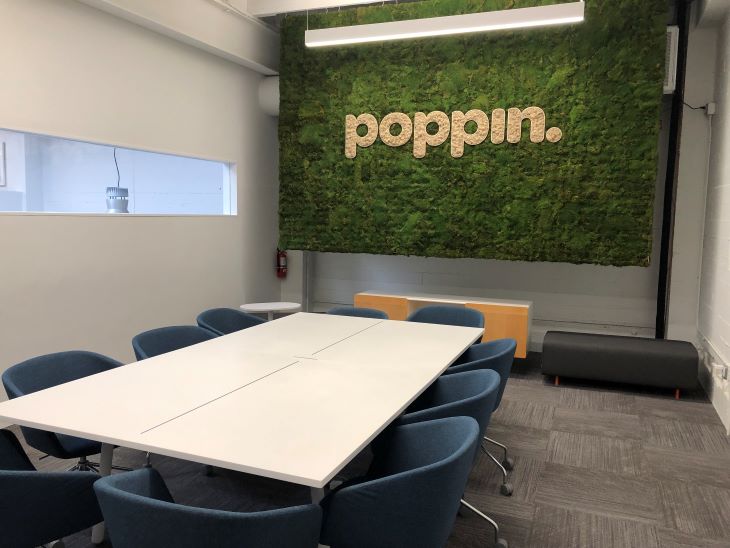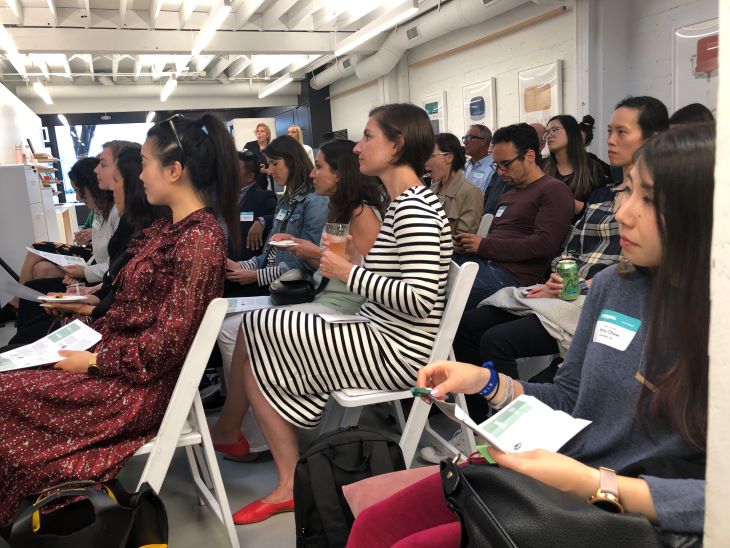At our recent event on September 10th, hosted in partnership with Poppin, we asked thought leaders in San Francisco what the future holds for workplaces.

At WDM we work hard to provide interesting content that speaks to what our readers are working on and want to know about the larger world of workplace planning and design. What we really love is to meet our readers and offer opportunities to learn something new, mingle with each other and share insights and observations with thought leaders in the industry. Recently, in partnership with innovative furniture manufacturer, Poppin we were able to host a dynamic panel discussion on the Future of the Workplace. Representing a diverse cross section of workplace professionals, a lively discussion ensued. Here are some of the key take aways from that event.

Bob Fox: Let’s set the context for our conversation – what is going to be different over the next five to ten years?
Katie Rodrigues: What is changing rapidly is how work is done. For example, the work process is more agile and demanding more interdisciplinary interaction. Teams are distributed and have to manage across geographies and time zones. We need to respond to how people are working with current tools and technology. It is all about flexibility. We are looking at increasing use of automation and AI, this is disrupting certain types of work and changing technology and real estate as we use more data and automation in planning and designing space.
Steve Carroll: On the human/HR side we have reached a point where we need to create physical space that is welcoming and encouraging more collaborative work processes. We are getting rid of enclosed offices and have more shared spaces. We have gone from the more traditional closed space to the chaos of totally open space. We are looking now for places that are more productive from a human standpoint. The future is all about getting talent and figuring out where to have workplaces that can draw that talent, not just in Silicon Valley or New York. We need to encourage more distributed work forces and have places for people to live and work in more affordable cities.
AI/Data will be more important, machines can do a lot, but it is the human connections that matter more. Data is power, we can rely on data, but we also need human interaction. The future workplace may not be designed in a traditional fashion, but we need to create collaborative environments that can incorporate the right technology to do our work.
Kimberly O’Dowd: People can work from anywhere; companies are supporting more distributed teams and remote workers from multiple locations. Creating the spaces where that work can be supported requires us to think about real estate in other ways, not just about putting “butts in seats”. Workplace is now about supporting multiple types of interactions, to get work done regardless of physical location. I agree that finding ways to collaborate across locations as companies look to locate in more affordable locations is going to be an important consideration going forward.
Meredith Zenkel: From the perspective of a furniture company, we try to be thinking ahead on what kind of products will support the workplace in the future. We sell all kinds of solutions, especially for more open office solutions. While AI driven data can predict what activities are doing and what kind of groups need certain furniture solutions, we want to create furniture that works for many levels of flexibility. We need to think about how much time is spent doing definable tasks and figure out what furniture solutions will support that flexible work mode. People “want it all” – virtual work, face to face collaboration, work at home!

Bob: How does the work environment support a variety of people?
Katie: We must understand and plan around managing the diversity in the workplace. The range of generations and skills gives us the chance to recruit talent across multiple areas. There needs to be consideration of subject matter experts, which may be the older workers and the data scientists how need to interpret data – there needs to be a balance of knowledge management requiring diverse quantitative skills. The information is there it is how you think about it, the human factor that is important.
Steve: From a non-scientific point of view – we need to get creative on how to write job descriptions. Understanding people’s strengths and how that fits into the larger puzzle of what a company needs, is not an exact science. We need to look at how people will align themselves to company values. Diverse personalities need to get along well. My boss is a rocket scientist and I am not, but we can communicate. We all need to know how our stuff fits into the big picture. We are not all cyborgs, and a variety of people can do things and approach problems from different perspectives, that may be the recipe for survival!
Meredith: At Poppin we think that it is important to have intention when designing an office. We ask our customers; how do you want your employees to live? A slide or game table is not important, it is the culture you are trying to create that is the driving force. You need to have something in mind that becomes the foundation of your business – that is what is now going to attract people. Think about the company you want to be and define the underling culture – we are finding that is what is now attracting talent. People seem to appreciate that even more than the physical amenities.

Bob: In a recent discussion with a CRE executive – he noted that 75% of their clients are now focused on culture as a critical part of the office space design challenge. As we learn more about the human brain and how people work, how do you think the furnishings or spaces are a way to differentiate or express a company’s culture?
Meredith: As part of our consultative process we try and define the key components of the workplace a client is trying to create. Are there branded elements and spaces, what kind of meeting spaces will best support your work? Sometimes simple things do the trick. You can’t build 2,000 meeting rooms for two people meetings, but you need to figure out how people are interacting and build spaces that support those activities.
Katie: We look at things across the tiers of a company’s organization – Organizational, Department and Team levels. Each level’s needs need to be evaluated in order to get balance across the entire planned space. We want to get people to want to come to work, with the expectation that they want flexibility to manage their space across the various levels of the organization. People do want a sense of family/team, sense of pride and ownership at those micro levels within the company culture.
Kimberly: One size does not fit all. We look at the big picture – employees’ range across five generations, mixes introverts with extroverts, a range of preferred behaviors and modes of working. Getting to know who you are designing for is a bit like starting the dating process. You need to find out more than the basics before you proceed further!
Bob: What about technology – how are people using things like Alexa and other digital assistants?
Katie: There are several products being used to help with the office experience. We have a proprietary system (JILL) that is a directory, can help find meeting space and coordinate schedules to arrange the meeting. These tools free up time so people can be more productive.
Bob: “I need collaborative space” is what everyone asks for, how do you accomplish the right mix of those spaces?

Kimberly: The solution varies from company to company – do they need one large meeting space in a a single room, or casual ‘bump zones’ for on the fly meetings. You must figure out where to put dedicated formal meeting settings balanced with spaces for more casual interaction. The furniture solution(s) need to support the use of all the technology needed to support meetings.
Steve: We have tested a variety of settings. We have a lot of workers with various work backgrounds ranging from blue collar positions like truck drivers to people with backgrounds in high tech jobs. Everyone has been thrown into our startup culture. So, our physical space must be welcoming to all. In our Dallas office we found that making our space more like a living room with a high level of comfort seems to work well so our rocket scientists and truck drivers can co-exist and collaborate in a familiar and friendly environment. This may be unique to us, but it works.
Bob: Where is the greatest potential for new workplaces and where are the friction points?
Kimberly: Amenity spaces! There must be a good balance of amenity space versus workspaces. Deciding how much and what kind of amenities must be weighed against having enough spaces for people to come in and do their assigned work. If a space isn’t working the way it is supposed to, there must be a redistribution of space.
Steve: I made the mistake of not looking at the office space where I was going to work until after the offer was made. When I came on board, the furniture looked like it came right out of a dumpster. But as a startup, the company took pride in the scruffy atmosphere. However, it is increasingly important to potential hires to see the workspace as part of the decision-making process – companies need to be thoughtful about how to invest in their workplace. How the workspace looks is a criteria that a potential hire may use to rule out or accept a position. Making an investment in space is also an investment in people. Physical space can be impactful.
Bob: People cost vs. space cost – what gives company’s the greatest value for their investment in their workplace(s)?
Meredith: How people work is supported by the value of their physical space. Work teams have different needs, and how the furniture is organized and utilized affects the work! The intention to create great space is a corporate value – it is not just spending money but making good decisions that support the overall company core values. There is more than one way to create a powerful environment. The design, colors, alignment with brand, all those factors (and more) do have meaning to people. These things all contribute to the overall workplace experience.

Bob: What about coworking? How is that playing into things?
Steve: Coworking is a great short-term solution. However, being in coworking space can make it hard to build a strong company culture. The big “fishbowl” space can seem fun for a while, but it makes it more difficult to create a company identity. The notion of collaboration seems “borrowed”. Sometimes this real estate solution is necessary, but our approach has become that once we hit fifteen employees it is time to find our own space.
Kimberly: With coworking there is no “ownership” of space, no feeling that “this is our space”. Borrowed space is just not the same as directly leased or owned space there is a lack of history and personalization.
Katie: Coworking is great! We have seen coworking design emerge from Starbucks to WeWork and the Wing…all these types of spaces are shaping how we think about office space. What elements of coworking do people like? Even the coworking providers are re-thinking their model to include spaces for larger companies/enterprise clients. We have worked with come of our clients to plan coworking spaces with a higher level of personalization as our large customers want more curated space.
Coworking has totally disrupted our industry and changed our thinking about everything. Property owners are now envisioning and implementing their own version(s) of shared spaces. Coworking can be part of a diverse real estate portfolio. Conversely, some companies are going all in to providing coworking space in lieu of traditionally leased properties.
Bob: Five to then years out what are the most disruptive factors in workplace going to be?
Meredith: I think there will be more predictive technology in platforms like Slack and Gmail. Project managers will need to work with more information to design better, think about space better and understand how people are using their time – based on the different sources of data that the new technology will provide.
Kimberly: I would think there will be more wireless technology, charging stations, less reliance on core drills for example to provide power. There will be more need to allow flexibility in how workspaces are arranged.
Steve: I agree on both points – I also think people will be looking to locate outside traditional (big city) markets when deciding where to locate their facilities. Not everyone needs to be in Silicon Valley to work in tech! People should be able to work anywhere – having technology that allows companies to bring everyone together whether they are in physical proximity or not.
Katie: Companies will be able to be more responsive to analyze space needs utilizing the data they are gathering with the new and emerging technologies. Spaces will be more flexible as how people work is changing.
Bob: Stretch your creative thinking – what is out there that doesn’t exist today?
Katie: More advanced virtual collaboration tools. Tools that will allow better ad-hoc remote collaborations this will affect how, where and when people work. Also getting your computer to talk to a display screen.
Steve: I would love to see that the HR and IT teams make sure that the advanced technologies are available to everyone – not just in Silicon Valley or other hi-tech locations. As the work force ages and changes and there are more diverse communities, we need to make sure things are accessible to a broader population. Also, developing more plug and play (ease of use) solutions.
Kimberly: Thinking about providing amenities as a community advantage – for example making some business amenities available to the neighborhood. For example, some companies make their meeting or social spaces available to outside entities. This can help free up real estate for other uses.
Meredith: Agreed, building more flexibility in how spaces are utilized. Construction spaces that used over longer periods of time.
Bob: Any final thoughts on how we should be moving into the future?
Steve: We have learned a lot over the past several years. We know more about open vs. closed workspace and that there is a balance of workplaces required to support how we work now and how we may work in the future. We always need to be thinking about “what’s next?”! We need to be open about what kind of environments we create and be flexible enough to adapt to new technologies and approaches to work.
Katie: Change is inevitable, things will be done differently, in different modes and in different proportion depending on required team tasks. Being able to have choice will enhance workplace flexibility.
Kimberly: Spaces that accommodate agility and the ability to change is key. Space design not static. We need to be designing spaces to manage growth and change. Companies will need to be smart about how they integrate technology into workspace.
Meredith: Balance is important. We need to look for the humanness of it all, community, micro families within companies. Even with all the technology – don’t lose sight of keeping in touch as people! Focus on human connection, that is how most of us get our jobs done.
Bob: It seems we have multiple paths to follow – we can be slaves to technology or focus on the purpose of the workplace/user experience – the human factors. Lot’s of food for thought here!
Did any of the perspectives resonate with you? What do you think the future of work entails? Comment below – we might invite you to write more!!
A note about our Partner, Poppin
Instant Workification! Poppin’s integrated family of products is designed to get your office up and running in 10 days or less. Each carefully-curated piece mixes, matches, and scales with your team so you can start up, start fresh, and start working happy. Check them out here.

